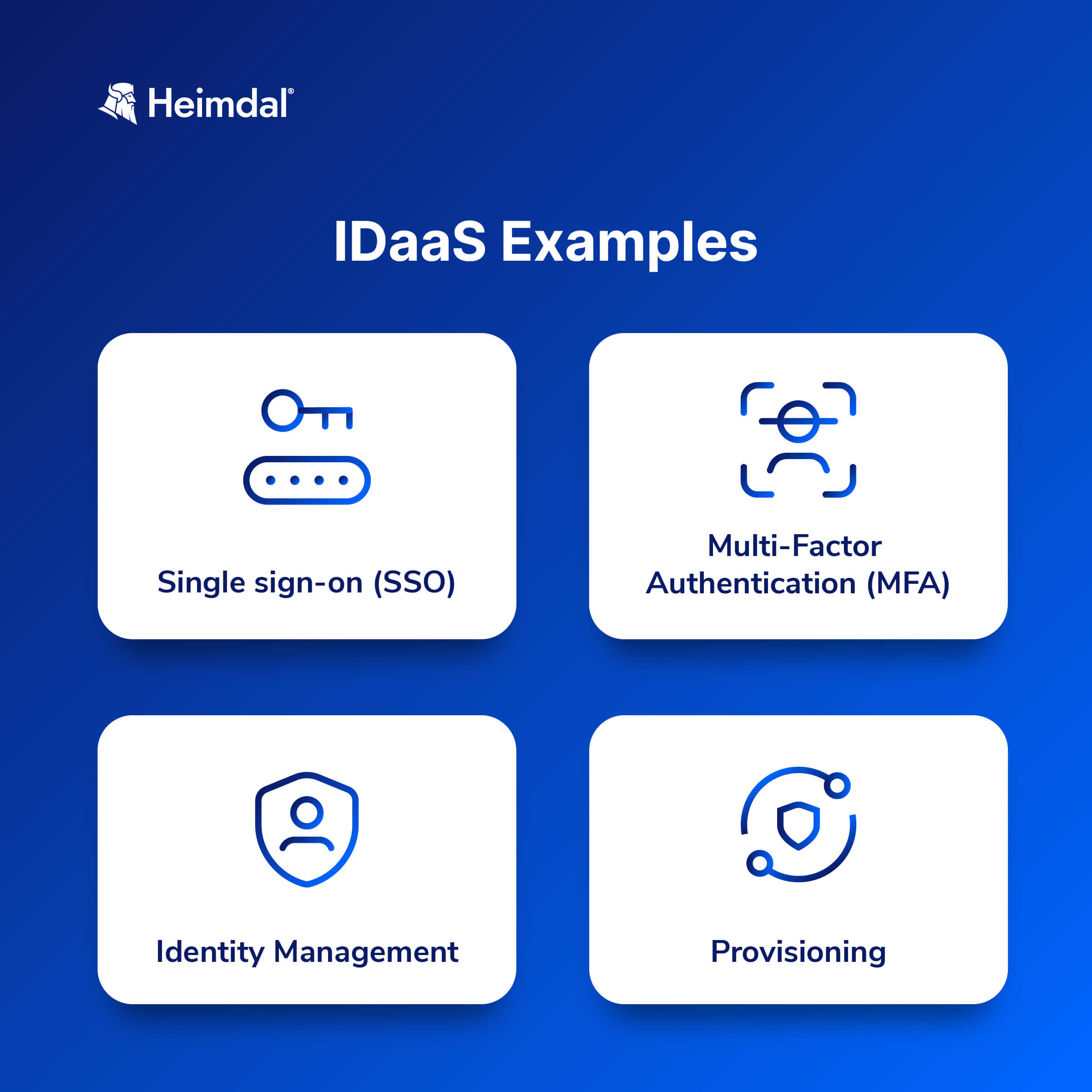Contents:
Identity as a Service (IDaaS) is an Identity and Access Management (IAM) solution that delivers identity & access services over the cloud.
In this article, we’re going to deep-dive into the specifics of IDaaS.
Key Points
- What is Identity and access management as a Service?
- A Brief IDaaS Timeline.
- How Does Identity as a Service Work?
- Why Do Organizations Need IDaaS?
- IDaaS Examples.
- Benefits of Identity as a Service.
- Is IDaaS Secure?
What is Identity and access management as a Service?
According to Gartner, IDaaS is
a predominantly cloud-based service in a multi-tenant or dedicated and hosted delivery model that brokers core identity governance and administration (IGA), access and intelligence functions to target systems on customers’ premises and in the cloud.
An identity service’s goal is to verify users are who they say they are. If the identity checks out, the solution grants them in-time access company resources.
If the necessary infrastructure is on-site, the organization will have to think out of what to do whenever an issue comes up.
For instance, if employees use their BYODs or switch devices, the local identity provisioning needs to readjust.
In this case, a centralized OTA system developed by experienced identity specialists is easier.
But before we dive deeper into this topic, let’s take a quick look at the beginnings of Identity as a Service.
A Brief IDaaS Timeline
Online ID management has been a vital security cog for organizations since the late ’90s.
Microsoft’s Active Directory, was the first to address the need for IAM technologies.
For smaller companies IAM technology is not feasible. This is due to the ever-increasing costs in implementation and maintenance.
These challenges led companies to remotely managed, third-party software solutions to happen.
SaaS solutions enabled businesses to reap the benefits of software minus the costs and risks associated with on-prem.
Also, , businesses can now easily integrate software into every layer of their IT infrastructure. This includes cloud environments and third-party services.
Since IAM software vendors now provide cloud-based IDaaS, access management software becomes accessible. Companies can now tap into IDaas without a significant initial investment.
How Does Identity as a Service Work?
With an IDaaS subscription, you will get an API or access to a portal.
Either method will allow you to merge your application suite with the identity solutions of the service provider. Their offer includes single sign-on, social login, adaptive authentication, and others.
An authentication request is sent by the API to the identity service provider. This happens each time a user enters their credentials into an application.
The IDaaS system confirms the user’s identity before granting them access to the requested.
In certain situations, IDaaS may also carry out authorization. They use policies to decide which resources/information a verified user has access to.
Why Do Organizations Need IDaaS?
The goal of IDaaS is to confirm that a user is who they claim to be and then allow access to apps once the user has been authorized.
IDaaS allows a company to outsource the operational details of an identity and access management solution.
This curbs company’s administrative burden by eliminating the need to manage infrastructure, provide security, configure and upgrade software, and back up data.
IDaaS offers scalable IAM that quickens digital transformation while cutting costs and risks.
Also, IDaaS plays a key role in meeting regulatory compliance standards.
Thanks to IDaaS, organizations are able to keep logs and get user records for auding purposes.
IDaaS Examples
These examples below work together to offer detailed access management and user verification capabilities for staff, vendors or clients.
By combining these features, you can provide users with a simplified control access experience across different apps.

Single sign-on (SSO)
Under Single Sign-On (SSO), a user is able to access multiple resources using one set of credentials.
Single sign-on allows employees, partners, and customers to access all SaaS, mobile, and enterprise apps. This is achieved with one authentication using their company credentials.
Multi-Factor Authentication (MFA)
Multi-factor authentication (MFA) means asking a user to present at least two different forms of IDs before granting them access.
These form fall into three categories or factors.
- What you know (your password).
- What you have (your phone).
- What you are (biometrics).
Identity Management
An Identity Provider (IdP) creates, stores and manages digital identities.
An IdP may perform user identity verification using user-password pairings and other factors.
Or, it may just give a list of user identities that another service provider checks. IdPs hosted in the cloud fit under the IDaaS umbrella
Provisioning
User provisioning means creating, changing, disabling and eliminating accounts & profiles across IT infrastructure.
Such solutions use several approaches to automate onboarding, offboarding, and other administration workforce procedures .
This includes new hires, transfers, promotions, and terminations.
Using IDaaS to automate these processes takes the pressure off you while reducing user-error risks.
Benefits of Identity as a Service
Let’s take a closer look at the benefits of IDaaS.
Enhance security
An advanced IDaaS solution secures identities while also safeguarding your IT environment.
Features like MFA, SSO, and password complexity, can help organizations control or restrict access. More than that, it can also improve security.
In a nutshell, with IDaaS solutions, organizations are better protected against security incidents. This can inclunde anything from ransomware attacks to costly incidents, breaches, and theft.
Reduced costs
As I mentioned before, provisioning identity on-premises can be expensive.
With IDaaS,companies to enjoy innovative technologies at an affordable monthly cost . Companies can expand their usage by adding more users and integrations as they grow.
Less work for IT teams
Besides reducing costs, IDaaS can simplify ongoing IT processes and free up teams to focus on key business operations.
Deliver access services efficiently
IDaaS helps with the distribution of user access across your enterprise. This streamlines the manage user identities process.
In addition, it enforces governance and compliance needs via self-service access request and provisioning.
Better user experience
By eliminating used password fatigue and allowing an efficient Single Sign-On, IDaaS.
IDaaS implementations that support identity federation standards. This includes SAML, OAuth, and OpenID Connect. ID federation enable users to get access to all their apps with only one set of credentials.
Whether a user signs in via open WiFi from a coffee place or a from the office, the process is consistent, effortless, and secure.
IDaaS also enables organizations to extend access across many stakeholders.
Increase revenue and customer loyalty
A positive first impression generated by a smooth authentication process increases consumer interactions and purchases.
It’s affordable for all organizations
IDaaS solutions make IAM technology available to any business.
IDaaS technology allows businesses to control exactly which users have secure access to what resources. All this without having to pay for expensive on-premises software.
Supports hybrid and remote work
IDaaS SSO can provide a simplified user experience. This can be a boon for employees who work across many devices and use many applications.
Outsourcing Identity Access Management, businesses can protect the remote workforce.
Compliance
IDaaS can assist your organization in replacing costly paper-based and manual access reviews and certifications with automated systems.
Also, companies can also derive repeatable practices to obtain more certifications.
Is IDaaS Secure?
There’s no doubt about it, Identity as a Service is the IAM solution of the future.
However, not all companies will find IDaaS suitable.
If you lack a directory platform or cloud computing solutions, IDaaS may be challenging to implement.
Outsourcing software entails putting your trust in a provider to keep your corporate data safe.
IAM technology handles confidential employee and customer data. This includes passwords, answers to security questions, and biometric information.
This sensitive data may be exposed in the event of a data breach at an IDaaS vendor.
Because many in-house IAM processes involve disparate tools, organizations that keep IAM on premises may expose less private information during a cyberattack.
What Choose Heimdal®?
We recommend integrating Privileged Access Management within your IAM strategy.
Data breaches involving compromised credentials have grown in number over time.
Due to the evolution and growth of the WFH approach, more and more users are granted privileges.
That’s why the necessity to merge Privileged Access Management (PAM) with Identity and Access Management (IAM).
Since privileged accounts have special permissions they need special attention and management. These permissions are granted via a powerful PAM strategy couple with an automated Privileged Access Management Solution. This will manage the approval/denial flow to privileged sessions.
A PAM solution will enforce the principle of the least privilege and here’s the benefit of it being integrated with IAM: this ensures that only the appropriate users, who can prove their identities via IAM, have access to the right systems, which are managed by PAM solutions.I

Heimdal® Privileged Access Management
- Automate the elevation of admin rights on request;
- Approve or reject escalations with one click;
- Provide a full audit trail into user behavior;
- Automatically de-escalate on infection;
If you liked this article, make sure you follow us on LinkedIn, Twitter, Facebook, and Youtube for more cybersecurity news and topics.


 Network Security
Network Security
 Vulnerability Management
Vulnerability Management
 Privileged Access Management
Privileged Access Management
 Endpoint Security
Endpoint Security
 Threat Hunting
Threat Hunting
 Unified Endpoint Management
Unified Endpoint Management
 Email & Collaboration Security
Email & Collaboration Security











